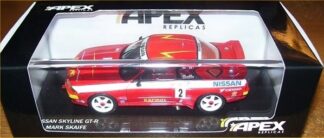Description
1/72 Spitfire MkIX Colin Gray
COR AA29102 Corgi 1/72 Supermarine Spitfire MkIXc, GC Colin Gray, Operation Husky July 1943 – 2023 Catalogue
SKU: COR AA29102
Desperate to ensure the Spitfire maintained its ongoing combat effectiveness, designers at the Vickers Supermarine Company were almost constantly engaged in modifying, upgrading and improving their famous fighter throughout the Second World War, however, during that time, there were occasions when unexpected Luftwaffe advancements called upon their flexibility and ingenuity. With a significant new variant of the Spitfire at the advanced stages of development, the introduction of a capable new German fighter aircraft in the skies over occupied Europe caused great concern amongst RAF officials, who were now losing Spitfires at an alarming rate and needed an immediate response. With the proposed squadron introduction of the new Spitfire Mk.VIII variant still some months away, Supermarine designers had the idea of mating the intended new powerplant for this aircraft, the Rolls Royce Merlin 60 series engine, with existing Spitfire Mk.V airframes already on the production line, a temporary solution which might just buy them the time they needed.
The idea was given official approval and the RAF’s Emergency Interim Fighter Programme got underway, with the new variant given the designation Spitfire IX, a stop-gap solution which would actually prove to be something of a fighting thoroughbred. In actual fact, this undertaking was not without several rather significant challenges for the team at Supermarine to overcome and but for the severity of the situation in the skies over Europe, may have actually been regarded as too problematic. Attaching the powerful new variant of the Merlin engine to existing Spitfire airframes was fraught with challenges, as the new unit was larger, wider and featured a redesigned rear section, all of which made this far from a simple exchange of engines. Supermarine technicians had to remove all existing systems and connections, design a new engine mount, then replace all fittings with newly upgraded components, all of which were essentially hand built. In fact, it could be argued that many of the first Spitfire Mk.IX fighters were hand built, with each one having an incredible number of man hours devoted to their production.
Once test aircraft were passed to the Air Fighting Development Unit and later the Aeroplane & Armament Experimental Establishment for extensive evaluation, it was found that this interim, stop-gap Spitfire was a marked improvement on existing Spitfires in performance terms. What had started as something of a desperate attempt to address a critical situation facing the Royal Air Force would actually result in the service introduction of an exceptional fighting aeroplane and a continuation of the incredible Spitfire story. The Spitfire Mk.IX would go on to be considered so successful that it would become the second most heavily produced variant in the entire production run of the fighter, second only to the Mk.V and if including aircraft powered by the American produced Packard Merlin in this number, actually eclipsed the Mk.V in terms of production number. It would also be the last major Merlin powered variant of the Spitfire, before the introduction of the mighty Griffon.
Just one of many Commonwealth airmen who served and fought with great distinction within the Royal Air Force during the Second World War, New Zealander Colin Falkland Gray initially had some difficulty in joining the force, failing twice to do so on medical grounds. Having spent some time improving his fitness levels, he was eventually accepted for a short service commission in the late summer of 1938, but rather than stay and train with the Royal New Zealand Air Force, elected to travel to Britain for his flying training, where he would gain his wings and later graduate as a probationary Pilot Officer in October 1939 without too many difficulties. This proved to be a rather tumultuous period for the Royal Air Force and Europe as a whole, as Britain and her allies were now at war.
By the end of the so called Phoney War, Gray was flying Spitfires with No.54 Squadron at Hornchurch, gaining as much operational experience as he could in advance of what seemed certain to be just around the corner, a clash with the all-conquering Luftwaffe. He would make his combat introduction during the Battle of France, flying patrol and fighter support sorties over the areas of Calais and Dunkirk, during which time he would gain both his first combat experience and his first aerial victory. He would go on to see plenty of combat action during the Battle of Britain and by the time No.54 Squadron were withdrawn for rest and replenishment, Gray had amassed an impressive total of at least 14.5 confirmed combat victories, making him the seventh most successful RAF pilot of the battle. With his victory tally continuing to grow, along with a succession of commendations, decorations and promotions, Gray would later take command of No.81 Squadron in the Mediterranean Theatre of Operations at the end of 1942, initially reporting to Gibraltar, where he and the rest of his new unit were to take delivery of their new Spitfire Mk.IX fighters, the first MTO squadron to do so. Operating from several airfields in North Africa, Gray would continue to score victories over his adversaries, which now included the opportunity to pit his flying skills against the fighters of the Regia Aeronautica.
During his time serving in the MTO, Gray continued to display exceptional airmanship when in combat and a burning desire to sweep the enemy from the skies. On one occasion, his Spitfire developed engine problems which forced him to abort his position in a sortie and return to his home airfield, but on arrival, found the base had just been shot up by several Focke Wulf fighter bombers. He immediately gave chase, but his engine was not producing its usual power output, so he was unable to catch them, but on transit back to his home airfield, he came across a lone Messerschmitt fighter, which he promptly dispatched. During his time serving in the Mediterranean, Gray would operate from airfields in North Africa, Malta and Sicily in support of the Allied war effort and by the time he returned back to Britain having accepted a staff position with No.9 Group, he had been credited with 27.5 aerial victories, a figure which made him the top scoring New Zealand air ace of the Second World War. Although he would fly operationally before war’s end, he would not increase his victory tally further.
In its striking desert livery, Gray’s Spitfire Mk.IX MA408 proves the old aviation adage that a Spitfire looks good in any colour, however, it has to be said that this one is particularly attractive. Colin Gray used this fighter during Operation Husky, the Allied invasion of Sicily, but was just one of several Spitfires in which he flew and scored victories during his time in the Mediterranean. He and his fellow MTO pilots effectively cleared the skies of Axis aircraft and helped pave the way for eventual Allied victory, both in this Theatre of Operations and further afield.
Colin Falkland Gray would retire from the Royal Air Force in early 1961, before returning to his native New Zealand




